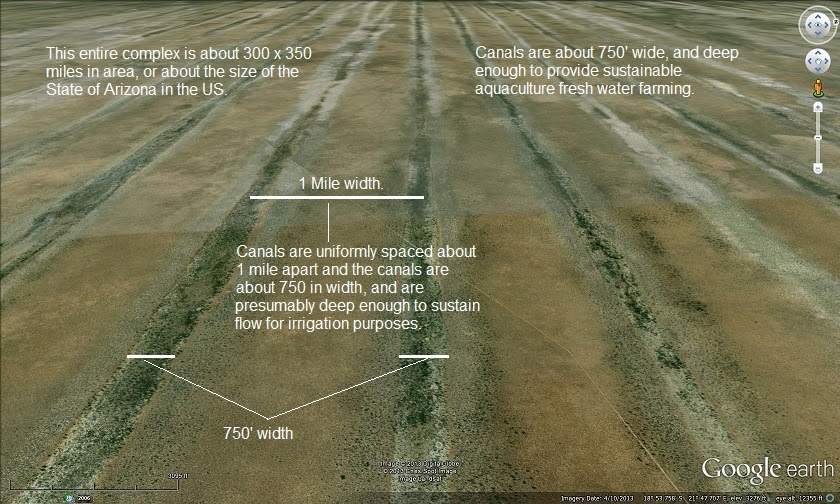The Largest Ancient Man Made Canal System on Earth
From my Free Web Book 'AncientCanalBuilders.com'
The largest wide-array man made (or at least non natural) structure in the world is in fact an ancient terra formed systems of agricultural-aquaculture canals in Northwestern Botswana
and Northeastern Namibia, north of the Kalahari Desert in Southern Africa. Obviously quite ancient,
the canal systems no longer provide free flowing water throughout its 105,000
mile array, but many sections show obvious intention to provide cross sectional irrigation.
These canals are too evenly spaced over too large an area to be any kind of natural formation. Based on entry and exit points, it is readily apparent this system is a very large, controlled agronomy array and/or aquaculture system. Its age is defined by the overgrown nature of the canals, as well as some areas that are covered over with drift and sand erosion.
These canals are too evenly spaced over too large an area to be any kind of natural formation. Based on entry and exit points, it is readily apparent this system is a very large, controlled agronomy array and/or aquaculture system. Its age is defined by the overgrown nature of the canals, as well as some areas that are covered over with drift and sand erosion.
The entire complex covers an area about equal in size to the State of Arizona in the USA. The
canals are an integrated system of apparent irrigation and agricultural (and probably aquaculture) design.
The system is about 350 miles in width and about 300 miles in depth. (For the remnants still visible.) This system represents roughly 67 MILLION acres of sustainable agriculture. Given the sophistication of design, it is entirely plausible to assume an above average yield, i.e. feeding well over 90 persons per acre on an annual basis. The system may or may not have provided a sustainable aquaculture (marine farming) environment. I have no reason to suspect that it did not.
Given the size and scope of this complex, (canals are about 1 mile apart on average) and collectively are roughly 350 X 300 miles in a rough rectangular format. (At least the observable parts) There could be, and probably is, much more to this complex than what is visible to the naked eye. Right now, we can identify ancient cultivation of roughly 105,000 square miles.
One square mile = 27,878,400 square feet, or 640 acres, so the entire complex had a sustained producing land mass of (640 acres x 105,000 square miles) or > 67,200,000 acres. (That is 67 MILLION acres)
One linear mile of canal had (750' width x + >12' depth x 5,280') = 47,520,000 cubic ft of water per linear mile.
Entire canal length (105,000 miles x 47.5 million cubic ft per mile) = 5,000,000,000,000 (That's 5 TRILLION) cubic feet of water in the canals. It would be an incredible waste of time and effort to irrigate >105,000 square miles of sustainable agriculture land, and not use the 5 trillion cubic feet of water circulating in the canals for aquaculture farming. I don't think the builders were that stupid.
Different estimates of the numbers of people this sustainable system would supply varies widely, though it is generally accepted that a system like this, if properly managed would provide a complete annual diet for somewhere between 60 to 120 people per acre. Which means this system was in fact providing food for an average of about 5 Billion people.
This array is in fact the largest non natural artifact on the Planet. It can be clearly viewed unaided from the International Space Station at roughly 230 miles up, which cannot be said for any other non natural feature on Earth.
I would suggest that depth of canal(s) must have been significant to compensate for general slight variations in elevation. There seems to be an average elevation variation of about 60', sometime more, and sometimes less.
Your comments are welcome, or you can contact me here:
johnmjensenjr@gmail.com
321-614-5040
First brought to my attention by Gary Schoening Here is his original Vimeo post:



